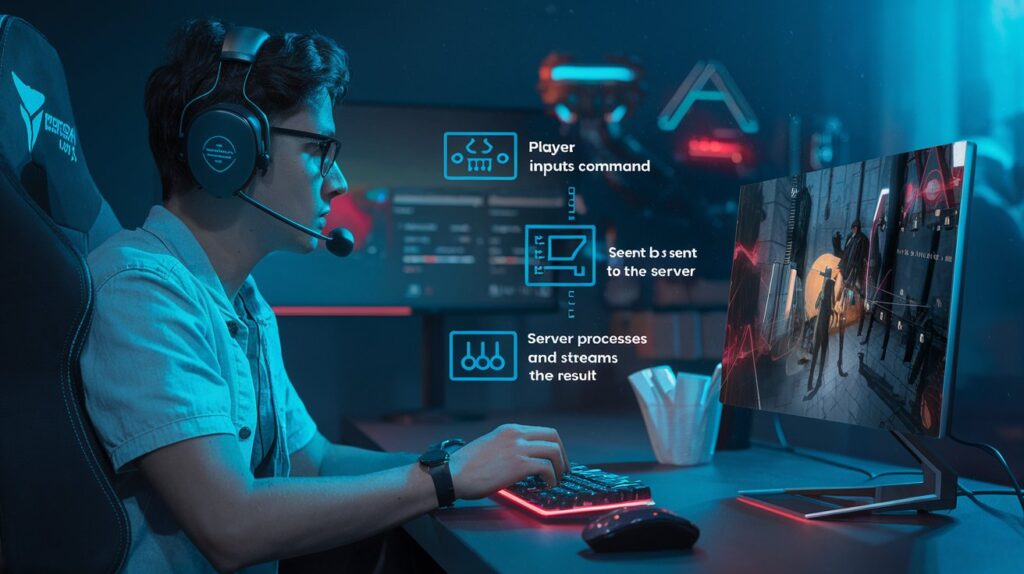Cloud gaming The future of entertainment? This question is at the forefront of discussions about the gaming industry’s evolution. With its promise to revolutionize the way people play, cloud gaming eliminates the need for expensive consoles or high-performance PCs, making high-quality games accessible to anyone with a stable internet connection. As technology advances and internet speeds improve, cloud gaming has the potential to break barriers, offering seamless gaming experiences across devices.
In a world where convenience is king, cloud gaming is not just a trend—it’s a game-changer. With major players like Microsoft, Google, and NVIDIA investing billions into this technology, the question is no longer if cloud gaming will dominate the market but how quickly it will redefine the entertainment landscape. This blog explores why cloud gaming is being hailed as the future and the opportunities and challenges it brings to the table.
Table of Contents
What is Cloud Gaming?
Cloud gaming, also known as game streaming, allows players to run games on powerful remote servers while streaming the gameplay to their devices. Instead of downloading or installing games locally, players can access them instantly. This innovation eliminates the need for costly consoles or high-performance PCs, making gaming more accessible.
How Does Cloud Gaming Work?
Cloud gaming The future of entertainment? Cloud gaming relies on servers hosted by providers such as NVIDIA GeForce Now, Xbox Cloud Gaming, and PlayStation Now. When a player starts a game, their commands (like movements or actions) are sent to the server, processed, and rendered on the server’s powerful hardware. The resulting video is streamed back to the player’s screen in real-time.
- Requires a fast and stable internet connection (minimum 15-20 Mbps).
- Reduces dependency on local storage or hardware upgrades.
- Offers a library of games that are updated frequently.

Advantages of Cloud Gaming
- Accessibility: Play on any device with minimal hardware requirements.
- Affordability: No need for expensive gaming setups.
- Scalability: Access a vast library of games with no installations or updates.
- Environmentally Friendly: Reduces e-waste by minimizing reliance on physical hardware.
Here’s a comparative table highlighting the differences between Traditional Gaming and Cloud Gaming:
Here’s a recreated comparative table with data included for better insight:
| Feature | Traditional Gaming | Cloud Gaming |
|---|---|---|
| Hardware Requirement | Requires gaming consoles ($300–$500) or high-end PCs ($1,000+). | Requires only a basic device (smartphone, tablet, or PC). |
| Upfront Cost | High: $1,000+ (hardware, games, accessories). | Low: Subscription costs range from $10–$30 per month. |
| Game Library Access | Limited: Games must be purchased individually ($20–$70/game). | Instant access to a large library with subscriptions. |
| Updates and Maintenance | Manual updates and frequent hardware upgrades every 3–5 years. | Automatically updated on provider servers. |
| Portability | Restricted to specific hardware setup in one location. | Play on any internet-enabled device, anywhere globally. |
| Latency | Minimal as games run locally. | Dependent on internet speed: recommended 15–50 Mbps. |
| Environmental Impact | E-waste generated by discarded consoles and upgrades. | Reduces e-waste with no physical hardware dependency. |
| Data Usage | Minimal data usage for offline play. | High: Streaming games uses 3–7 GB/hour for 1080p quality. |
Cloud gaming The future of entertainment? Challenges in Cloud Gaming
While cloud gaming holds immense promise, it also faces challenges:
- Latency Issues: A slower internet connection can lead to lag.
- Data Usage: High-quality streaming consumes significant bandwidth.
- Regional Limitations: Availability may vary across regions.
Is Cloud Gaming Truly the Future?
Cloud gaming is undoubtedly a significant step forward in the entertainment industry. As internet infrastructure improves and more players adopt the technology, it has the potential to become a mainstream method of gaming. However, addressing latency, cost, and accessibility challenges will be crucial to its success.
Conclusion
Cloud gaming The future of entertainment? The numbers strongly suggest it is. By 2024, the global cloud gaming market is projected to reach over $8 billion, growing at a compound annual growth rate (CAGR) of 45%. This rapid growth reflects its appeal to gamers seeking flexibility, cost-efficiency, and cutting-edge technology. Additionally, as 5G networks expand and internet speeds improve globally, issues like latency and connectivity will likely diminish. With major tech giants such as Google, Microsoft, and NVIDIA investing heavily in cloud gaming platforms, it’s clear that this technology is here to stay.
For gamers, cloud gaming offers access to a massive library of games without the upfront cost of hardware. For developers, it opens doors to wider audiences and new revenue streams. As the technology matures, it’s poised not just to complement traditional gaming but to redefine entertainment as we know it. The question isn’t whether cloud gaming is the future—it’s how soon it will become the norm.